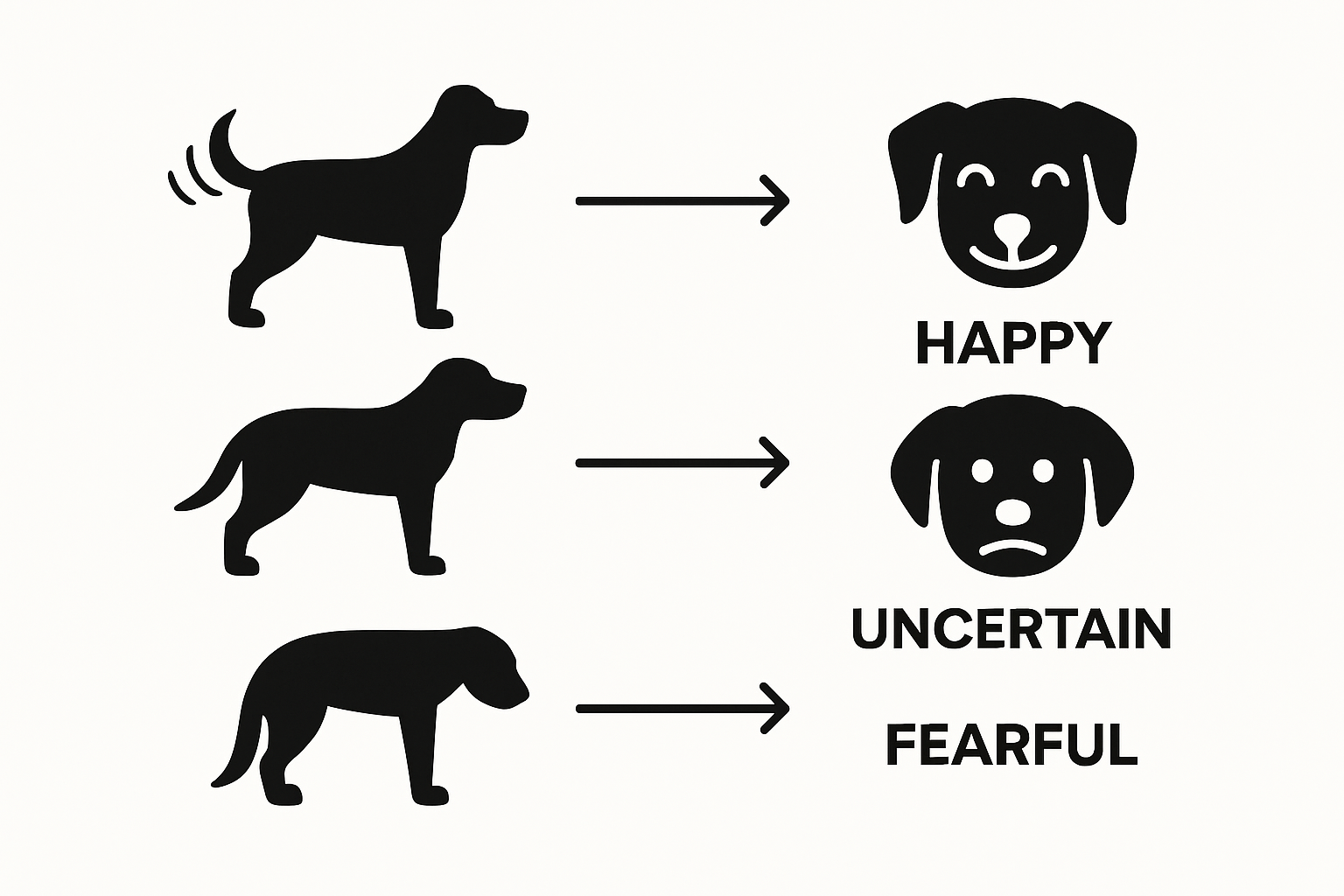Dogs feel more than most people realize. Research shows that dogs experience core emotions like joy, fear, and even love using similar brain chemistry as humans. You might think those tail wags and ear twitches are simple habits. The surprise is that every bark, glance, or nuzzle reveals a complex emotional code only now being understood.
Table of Contents
- The Emotional Lives Of Dogs: An Overview
- How Dogs Communicate Feelings Through Body Language
- Vocalizations: The Sounds Of Canine Emotions
- The Role Of Context In Understanding Dog Emotions
- Why Recognizing Dog Emotions Matters For Owners And Trainers
Quick Summary
| Takeaway | Explanation |
|---|---|
| Dogs experience complex emotions similar to humans. | Research shows dogs feel joy, fear, anger, love, and anxiety, underlying their emotional intelligence. |
| Tail movements convey specific emotional states. | Observing tail position and movement can reveal a dog’s emotional status, such as happiness or fear. |
| Dogs communicate feelings through body language. | Factors like ear position and posture contribute to a dog’s emotional expression, indicating comfort or distress. |
| Context is crucial for understanding dog emotions. | The environment and situational factors shape a dog’s emotional responses, influencing how signals are interpreted. |
| Recognizing emotions enhances training effectiveness. | Emotional awareness in dogs allows trainers to adapt their methods, fostering a collaborative learning environment. |
The Emotional Lives of Dogs: An Overview
Dogs are not just pets they are complex emotional beings capable of experiencing a rich and nuanced internal world. Understanding how dogs show emotions requires recognizing their sophisticated emotional intelligence and communication systems.
The Science of Canine Emotions
Research from the National Institutes of Health confirms that dogs experience emotions similar to humans, demonstrating neurological and behavioral patterns that reveal deep emotional capacities. Their emotional landscape includes fundamental feelings like joy, fear, anger, love, and anxiety.
The emotional lives of dogs are driven by intricate neurochemical processes. Hormones like oxytocin play a significant role in bonding and emotional attachment, helping dogs form deep connections with their human companions. These emotional experiences are not random but structured responses shaped by evolutionary adaptations and social interactions.
Communication of Emotional States
Dogs communicate their emotional states through multiple channels:
- Facial expressions revealing subtle mood changes
- Body posture indicating comfort or stress
- Vocalizations signaling different emotional intensities
- Tail movements expressing various emotional nuances
Interestingly, dogs have developed remarkable abilities to read and respond to human emotional cues. This emotional intelligence allows them to provide comfort, support, and companionship in ways that transcend simple animal behavior.
Emotional Complexity and Individual Variation
Just like humans, each dog has a unique emotional profile. Factors such as breed, individual personality, past experiences, and environmental conditions significantly influence how they experience and express emotions. Some dogs might be more demonstrative, while others remain more reserved in their emotional displays.
Understanding these emotional intricacies helps dog owners develop deeper, more empathetic relationships with their canine companions. By learning more about dog training and emotional connections, owners can create supportive environments that nurture their dogs emotional well being and strengthen their bond.
How Dogs Communicate Feelings Through Body Language
Dogs are masters of nonverbal communication, utilizing an intricate system of physical signals to express their emotional states. Their body language serves as a complex communication network that allows them to convey feelings, intentions, and reactions without uttering a single sound.
This table outlines several common dog body language cues, their possible emotional meanings, and tips for interpretation to help owners better recognize their dog’s feelings.
| Body Language Cue | Possible Emotional State | Interpretation Tips |
|---|---|---|
| High, wagging tail | Excitement, happiness | Context matters—check for relaxed posture |
| Low, slow wagging tail | Uncertainty, mild anxiety | Look for other signs of stress |
| Tucked tail | Fear, submission | Usually paired with crouched body/averted gaze |
| Stiff, raised tail | Alertness, potential threat | May precede vocalizations or aggressive stance |
| Relaxed mouth & eyes | Contentment, calmness | Typical in safe, familiar environments |
| Tense body & hackles up | Threat, stress | Often signals discomfort, distance advised |
Tail Movements and Emotional Signaling
Research from the Journal of Animals reveals that tail movements are far more than simple wagging. Different tail positions and movements communicate distinct emotional states:
- A high, rapidly wagging tail indicates excitement and happiness
- A low, slow wag suggests uncertainty or mild anxiety
- A tucked tail signals fear or submission
- A stiff, raised tail can indicate potential aggression or heightened alertness
These nuanced tail signals provide immediate insight into a dogs internal emotional landscape, allowing observant humans to understand their companion’s psychological state with remarkable precision.

Facial Expressions and Postural Cues
Dogs communicate through subtle yet powerful facial and bodily expressions. Ear positioning, eye contact, mouth tension, and overall body posture work together to broadcast emotional information. A relaxed, open mouth with soft eyes suggests contentment, while a tense body with raised hackles communicates potential threat or stress.
Interestingly, dogs have evolved sophisticated abilities to read human emotional cues, creating a remarkable interspecies communication system. This emotional intelligence allows them to adjust their behavior based on human emotional states, demonstrating an extraordinary level of empathetic connection.
Context and Individual Variation
While general body language principles apply across dogs, individual personality and breed characteristics significantly influence emotional expression. Some dogs are more demonstrative, while others remain more subtle in their communication.
To better understand these nuanced communication strategies, explore our guide on advanced pet communication techniques. Learning to interpret these signals can dramatically improve human dog relationships, creating deeper understanding and more meaningful connections.
Vocalizations: The Sounds of Canine Emotions
Dogs possess a remarkable vocal repertoire that serves as a sophisticated communication system, allowing them to express complex emotional states through various sounds. These vocalizations are far more than simple noise they represent nuanced emotional signals that convey feelings, needs, and intentions.
Types of Canine Vocal Expressions
Research from animal behavioral studies reveals that dogs utilize multiple vocal types to communicate different emotional experiences:
- Barks indicating alertness, excitement, or warning
- Whines expressing anxiety, submission, or seeking attention
- Growls signaling potential threat or discomfort
- Howls communicating loneliness or group connection
- Yelps representing sudden pain or surprise
Each vocalization carries specific emotional undertones, providing sophisticated communication beyond simple noise making. The pitch, duration, and intensity of these sounds contribute crucial information about the dogs internal emotional landscape.
To clarify the emotional meanings behind different dog vocalizations, the following table summarizes key types of canine sounds and their associated emotional states.
| Vocalization Type | Associated Emotions | Example Situations |
|---|---|---|
| Bark | Alertness, excitement, warning | Visitor at door, play, perceived threat |
| Whine | Anxiety, submission, seeking attention | Wanting to go outside, separation from owner |
| Growl | Threat, discomfort | Guarding food, feeling threatened |
| Howl | Loneliness, group connection | Left alone, responding to distant sounds |
| Yelp | Sudden pain, surprise | Accidentally stepped on paw, startled |
Emotional Processing and Communication
Dogs demonstrate extraordinary abilities in processing emotional vocalizations. Their brains asymmetrically process sounds with different emotional valences, suggesting a complex neurological mechanism for understanding and responding to auditory emotional cues.
Interestingly, dogs not only communicate their own emotions but also excel at interpreting human vocal emotional signals. They can distinguish between happy, sad, and angry tones, adjusting their behavior accordingly. This remarkable skill highlights the deep emotional intelligence that allows dogs to form profound connections with their human companions.
Context and Individual Variation
While general vocalization principles exist, individual dogs vary significantly in their vocal expressions. Breed characteristics, personal temperament, and past experiences shape how each dog communicates through sound. Some dogs are more vocal, while others remain relatively quiet.
Discover advanced techniques for understanding your dogs vocal language to build stronger, more empathetic relationships. By learning to interpret these nuanced vocal signals, owners can gain deeper insights into their dogs emotional world.
The Role of Context in Understanding Dog Emotions
Understanding dog emotions requires more than observing isolated signals. Context plays a critical role in accurately interpreting the complex emotional landscape of our canine companions, transforming seemingly simple behaviors into meaningful communication.
Environmental and Situational Influences
Research from Frontiers in Psychology reveals that emotional interpretation depends heavily on surrounding circumstances. Dogs experience and express emotions dynamically, with their responses deeply influenced by:
- Physical environment and spatial context
- Previous experiences and learned associations
- Immediate social interactions
- Physiological state and energy levels
- Presence or absence of familiar humans or animals
A wagging tail might signify excitement in one context but indicate anxiety in another. Similarly, a growl could represent playfulness during a game or a serious warning in a threatening situation. These nuanced expressions underscore the importance of holistic emotional understanding.
Psychological and Social Dimensions
Dogs possess remarkable emotional intelligence that allows them to read and respond to subtle contextual cues. Their ability to interpret human emotions and adjust their behavior accordingly demonstrates a sophisticated understanding of social dynamics.
Emotional responses are not isolated events but intricate interactions between internal states and external stimuli. A dogs emotional display emerges from a complex interplay of individual personality, past experiences, current physiological conditions, and immediate environmental factors.
Individual Variation and Emotional Complexity
No two dogs experience emotions identically. Breed characteristics, individual temperament, socialization history, and personal experiences shape each dogs unique emotional landscape. What triggers fear in one dog might provoke curiosity in another.
Learn more about understanding your dogs unique emotional communication, recognizing that emotional interpretation is an art as much as a science. By developing sensitivity to context, owners can forge deeper, more empathetic connections with their canine companions.
Why Recognizing Dog Emotions Matters for Owners and Trainers
Emotional intelligence is not exclusive to humans. For dog owners and trainers, understanding canine emotional landscapes is crucial for building trust, facilitating effective communication, and creating positive training experiences.
Building Trust and Communication
Research from veterinary behavioral studies demonstrates that recognizing and responding to a dogs emotional state directly impacts the quality of human animal relationships. Dogs are sensitive beings who communicate complex emotional experiences through subtle signals that require careful interpretation.
Emotional attunement allows owners to:
- Recognize signs of stress or discomfort
- Prevent potential behavioral issues
- Create safe and supportive training environments
- Develop deeper emotional connections
- Respond appropriately to individual dog needs
By understanding these emotional signals, owners transform training from a transactional process into a collaborative, empathetic interaction.
Training Effectiveness and Emotional Awareness
Successful training depends on more than just command repetition. Dogs learn most effectively when they feel secure, understood, and emotionally regulated. Specific body language cues like relaxed ears, soft eyes, and calm posture indicate receptiveness to learning.
Emotional awareness helps trainers adapt their approaches, recognizing when a dog might be too anxious, overstimulated, or tired to engage productively. This nuanced understanding prevents frustration for both the dog and the trainer, creating more positive learning experiences.
Preventing Misunderstandings and Stress
Many behavioral problems stem from misinterpreted emotional signals. Dogs cannot verbalize their feelings, so misreading their emotional state can lead to increased anxiety, aggression, or withdrawal.
Explore advanced techniques for emotional training and bonding to transform your approach from simply teaching commands to truly understanding your dogs emotional world. Recognizing and respecting your dogs emotions is the foundation of a trusting, cooperative relationship.

Transform Your Dog’s Emotional Communication Into Action
Is your dog struggling to express their needs, or do you sometimes worry about missing subtle emotional cues? The article highlighted how dogs rely on body language, vocalizations, and behavioral signals to reveal their inner world, but many owners still face challenges truly understanding their pets—especially when safety or independence is at stake. This gap can feel even wider for those living alone, managing a disability, or caring for a new puppy or rescue dog. Imagine a world where your dog could press a button to let you know exactly what they need, whether it is going outside or signaling for help. Our iPupPee communication device bridges the gap between canine emotion and human response, turning emotional signals into clear action and offering peace of mind for you and your furry friend.

Experience how cutting-edge technology can nurture trust, connection, and safety for both you and your dog. Discover firsthand stories from people who have transformed their relationships by giving their dogs a voice. Visit https://ipuppee.com to learn more and start building a truly responsive bond with your dog. Need help introducing advanced training or want practical strategies for emotional connection? Explore more useful tips in our dog training and emotional benefits article and see how simple tools can support your unique needs. Take the step now to empower your dog’s emotional language with iPupPee.
Frequently Asked Questions
What emotions can dogs experience?
Dogs can experience a range of emotions similar to humans, including joy, fear, anger, love, and anxiety.
How do dogs communicate their emotions?
Dogs communicate their emotions through body language, facial expressions, vocalizations, and tail movements, each conveying different emotional states.
Why is understanding dog emotions important for training?
Understanding dog emotions is crucial for building trust, improving communication, and creating positive training experiences by recognizing signs of stress or comfort.
What role does context play in interpreting dog emotions?
Context is vital in interpreting dog emotions, as a behavior may mean different things depending on the situation, environment, and the dog’s previous experiences.

